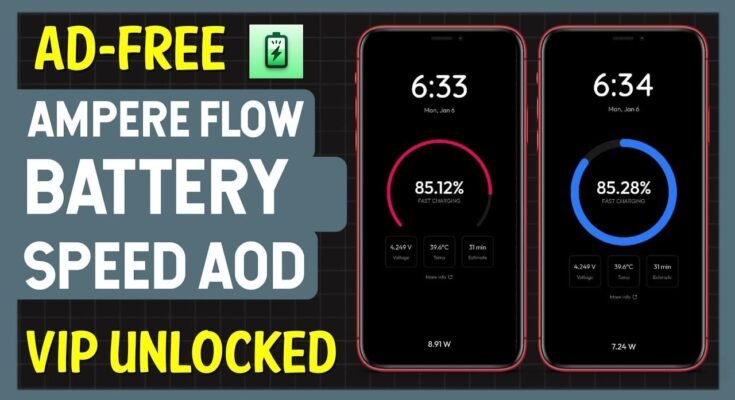In our digital-first world, smartphones have become essential companions. From communication to content creation, and work to entertainment, everything relies on one critical component: the battery. You may have noticed your phone not lasting as long as it used to, even with the same usage. This isn’t just your imagination — it’s directly linked to your device’s battery health and percentage.
Understanding battery health can help extend your device’s life and save money in the long run. In this article, we’ll explain what battery health and percentage mean, how they affect your phone’s performance, what features to look for, and which alternatives you can explore for battery monitoring.
What is Battery Health and Percentage?
Battery health and battery percentage are often confused but serve different purposes.
-
Battery Percentage tells you how much charge is currently left in your battery — for example, 80% means you have 80% of the full charge available.
-
Battery Health, on the other hand, reflects the battery’s ability to hold a charge compared to when it was new. Over time, batteries degrade, and your phone might only hold 80% of the charge it did when new, even if it says “100% charged.”
Battery health gives insight into the longevity and efficiency of your battery, while battery percentage is just a real-time indicator of remaining power.
Battery Health and Percentage
When you first buy a new phone, the battery operates at 100% health. However, lithium-ion batteries — the most common type used in smartphones — naturally degrade over time. With each charge cycle (using 100% of the battery, not necessarily in one go), the battery’s capacity decreases slightly. After a year or two, it’s normal for a phone battery to drop to around 85–90% health.
You can usually check battery health through system settings. For instance, iPhones have a built-in feature under Settings > Battery > Battery Health, while Android devices may require third-party apps or specific manufacturer tools like Samsung Members or OnePlus Diagnostic.
Keeping an eye on this metric helps determine whether it’s time for a battery replacement or a shift in your charging habits.
Features of Battery Health and Percentage [Completely Detailing]
Here are the key features of monitoring battery health and percentage:
1. Real-time Battery Monitoring
Most smartphones show real-time battery percentage on the status bar. This helps users manage usage during the day and know when to plug in their device.
2. Battery Usage Reports
Detailed usage graphs display which apps are consuming the most battery power. This feature helps you spot power-hungry apps and adjust your usage.
3. Battery Health Status
Phones like iPhones show battery health as a percentage (e.g., 88%) and whether the battery supports peak performance. Some Android devices require external apps like AccuBattery or Battery Guru for similar metrics.
4. Charging Cycle Count
Advanced tools provide data on how many charge cycles your phone has gone through — this is crucial because most batteries are rated for 300–500 cycles before noticeable degradation.
5. Optimized Charging
Some phones slow down charging overnight or keep the battery at 80% in certain conditions to reduce wear and tear. This feature helps maintain battery health over time.
6. Thermal and Voltage Readings
Apps can also display the battery temperature and voltage, which are key indicators of battery stress. Overheating can drastically reduce battery lifespan.
Pros of Battery Health and Percentage [Use Table]
| Pros | Explanation |
|---|---|
| Prevents Unexpected Shutdowns | Monitoring health helps avoid crashes when the battery is weak. |
| Increases Device Lifespan | Proper management delays battery degradation. |
| Optimizes Charging Behavior | Knowing when to charge helps avoid overcharging and overheating. |
| Improves Power Management | Users can adjust app usage to save battery based on accurate data. |
| Helps with Resale Value | A well-maintained battery boosts second-hand phone prices. |
| Detects Defective or Aging Batteries | Health monitoring helps detect when a battery needs replacement. |
Cons of Battery Health and Percentage [Use Table]
| Cons | Explanation |
|---|---|
| Not Always Accurate | Some apps show estimates, not exact data. |
| Varies Across Devices | Different phone brands show battery stats differently. |
| Overemphasis May Cause Anxiety | Constantly checking battery health can lead to unnecessary stress. |
| Requires Third-party Apps on Android | Not all Android phones have built-in battery health monitors. |
| Can’t Restore Lost Capacity | Once battery health declines, it can’t be restored — only replaced. |
Battery Health and Percentage Alternatives [Use Table]
| App/Tool | Platform | Features |
|---|---|---|
| AccuBattery | Android | Measures battery usage, charge speed, health estimate, temperature. |
| CoconutBattery | macOS | Displays iPhone/iPad battery health when connected to Mac. |
| Battery Life | iOS | Provides real-time stats, health reports, and charging cycles. |
| GSam Battery Monitor | Android | In-depth usage stats, app drain reports, and battery status notifications. |
| Ampere | Android | Shows charging speed, temperature, voltage, and battery capacity. |
| Apple Battery Health | iOS (Built-in) | Displays health percentage and performance capability for iPhones. |
Battery Health and Percentage
Maintaining good battery health isn’t complicated — it just requires a little awareness. Avoid letting your phone overheat, don’t always charge to 100% or drain it to 0%, and consider using optimized charging features when available.
If your battery health drops below 80% and you’re facing performance issues, it may be time to replace the battery. Many authorized service centers can replace the battery without needing a full phone upgrade, saving you money and extending your device’s life.
In conclusion, battery health and percentage are more than just numbers. They provide valuable insight into your phone’s efficiency, performance, and longevity. With the right tools and habits, you can keep your device running smoothly for years to come.



